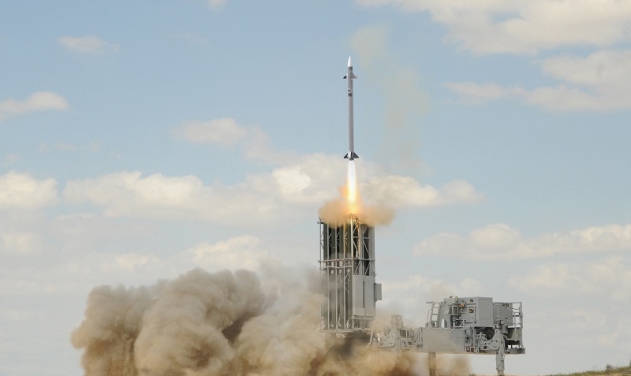
Land-based Barak 8 Credit: IAI
TEL AVIV: Israel has an operational system to protect against cruise missiles like the ones used by Iran to attack the Saudi oil installations, Breaking Defense has learned.
The Barak-8ER system, developed by Israel Aerospace industries (IAI), was recently upgraded and is now operational.
Boaz Levy, IAI’s VP and general manger of its missiles and space division, told me that the Barak-8 extended range version will add to the Israeli capability to protect itself from cruise missiles. The new version has enhanced anti-tactical ballistic missile capabilities. “The Effective Warhead can kill many types of missiles,” Levy said, adding that the missile features high immunity to electronic countermeasures.
The Barak-8 interceptor is part of the Barak MX System. The interceptors boast vertical launch capabilities supporting 360-degree coverage, quick reactions, short minimal ranges and an active high-end RF seeker for targets with low radar cross sections (RCS) and high maneuverability.
As Breaking Defense readers know, the cruise missiles used in the attack on the Saudi oil installations were Qudas 1s, powered by jet engines built in Iran based on a Czech engine. In addition, there were eight loitering weapon systems. They were developed in Iran based on technology acquired in other countries.
According to updated intelligence, the Iranians are investing big sums to upgrade their cruise missiles and build new ones. Israel has been worried for some time by this threat and improved its Barak-8 air defense missile systems to try and minimize any capabilities gaps.
The newest member of the Barak-8 family is the ER version. The regular ship-based Barak-8 has an effective range of 70km. The ER version, with its add-on booster, has the range of 150km.
Levy said that the Barak-8 protects against a variety of aerial platforms and munitions including aircraft, helicopters, unmanned aircraft and sea-skimming missiles. It is based on a sophisticated missile (developed with Rafael), a phased-array multi-mission radar, two-way data link, and command and control system.
The system’s radar delivers an accurate, high quality, real-time arena situation picture and extracts low Radar Cross Section (RCS) targets even in the toughest environmental conditions. Barak-8 can operate day and night, in all weather conditions, and can deal with simultaneous threats engagements even in severe saturation scenarios.
A Barak-8 system is deployed on an Israeli navy’s SAAR -5 missile ship and will be one of the systems on the Israeli navy’s new SAAR -6 ships being built in Germany. Some of the Barak-8 systems aboard the Israeli navy ships will be capable of protecting Israeli cities from cruise missile, Levy said.
Israel already has deployed systems to counter the other threat the Iranians demonstrated: armed drones.
 Elta, IAI’s electronic subsidiary, has developed the Drone Guard System that blocks an enemy system’s communication capability without compromising the communications of nearby civilians. Drone Guard uses 3D radars that trace the targets, electro-optical and COMINT sensors, and a dedicated UAS flight disruption system.
Elta, IAI’s electronic subsidiary, has developed the Drone Guard System that blocks an enemy system’s communication capability without compromising the communications of nearby civilians. Drone Guard uses 3D radars that trace the targets, electro-optical and COMINT sensors, and a dedicated UAS flight disruption system.
Rafael Advanced Defense Systems Ltd. has the Drone Dome, a radar and laser-beam system for detecting and destroying drones. Drone Dome can also disrupt communications between the drone and its operator. Drone Dome’s range reaches several miles, but causes minimal interruptions to other systems in nearby urban areas. A laser weapon is optional.
Airbus, UK agree $152 million deal for 6 H145 ‘overseas’ helicopters
The fleet of light-twin rotorcraft will replace Airbus Puma HC2 types, which have been temporarily based in Brunei for British Army training and the island of Cyprus in support of Royal Air Force search and rescue missions.


























